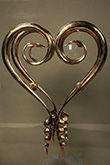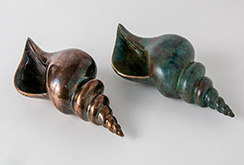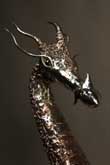Bronze; Timeless and Steeped in Antiquity |
"... Verdigris; where engineering becomes art ..."
Historically bronze was made by alloying copper with a small amount of tin. This mixture is still used today, but for forge work, blacksmiths also use bronzes alloyed with either aluminium or silicon.
Unlike steel, which can worked within a wide range of temperatures, bronze only has a narrow window; too hot and it crumbles when struck, too cold and it may split and crack. Because of this, bronze is time consuming and difficult to forge. However, the results are worth the effort, since forged bronze has a wonderfully rich, textured and worked appearance. This can be further enhanced by selectively polishing it.
Bronze has a lustrous shine when polished, the colour of which varies from a deep rich chestnut brown, through to a warm golden yellow hue, depending on the
composition of the alloy. Its colours are particularly effective as a counterpoint to steel when
featured as a detail. The metal can be treated chemically to richly
patinate its surface. A large and creative
spectrum of tones, colours and effects are possible depending on the
process and chemicals used.


